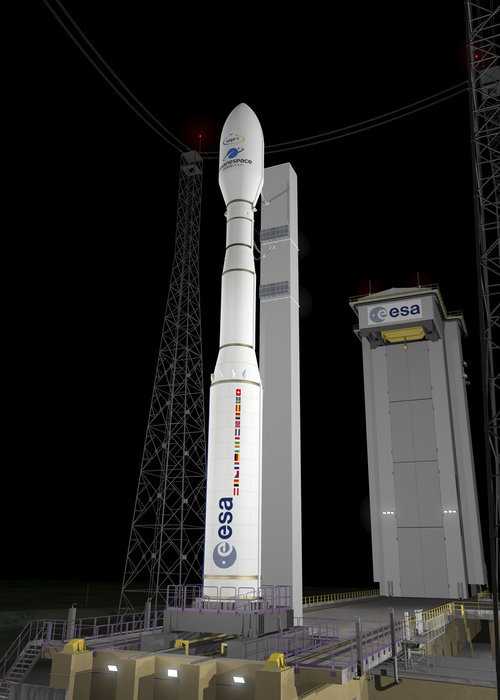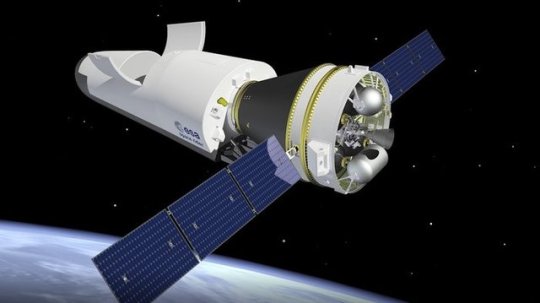#spaceflght
Photo


ALL ENGINES GO FOR VEGA-C MAIDEN FLIGHT ESA is working with industry towards the maiden flight of Europe’s new Vega-C launch vehicle in 2020 for more launches, with increased performance, to more orbits. Since the previous update on the status of Vega-C in December, the project has moved into the qualification phase following a successful critical design review in March. Final tests in this phase will verify the design and manufacturing processes, assembly and flight hardware and software, and associated ground support systems. Computer flight simulations will show the space and ground segment work together as they should. Industry is keeping pace with the tight schedule. The hot firing tests of the P120C first stage in Kourou, and the Zefiro 40 second stage in Sardinia qualify these solid rocket motors for flight. Additionally aerodynamic wind tunnel tests, vibration, structural and shock tests have been performed. These milestones mark the completion of all engine and motor testing. Reviews of the system and subsystems integrating all launcher system and launch base aspects have also been successfully completed. This will be followed by a launch system preliminary requirements review planned mid-2019. At Europe’s Spaceport in French Guiana, further adaptations to the existing Vega launch complex in preparation for Vega-C launches have been completed. Mobile gantry cantilever reinforcements, platform shutters, a new mast sector and a new overhead travelling crane are now installed. Europe’s current Vega has demonstrated unparalleled reliability since 2012 and impressive capabilities ranging from equatorial to Sun-synchronous orbits, from orbital to suborbital missions, from single to multiple payloads. Vega-C builds on these capabilities and will become the pillar of the Vega Space Transportation System, offering a range of payload carriers for different shapes and sizes of payloads ranging from 1 kg to 2300 kg, for ‘access to’, ‘operations in’, and ‘return from’ space. In a proof of concept flight this summer, Vega will deploy multiple small satellites using its new payload carrier system, the Small Spacecraft Mission Service, or SSMS, for the growing small satellites market. This rideshare launch will carry seven microsatellites and 35 CubeSats. The SSMS will also launch on Vega-C from 2020 offering 700 kg of extra payload capacity inside a larger fairing. Additional payload adaptors include an enhancement to Vega’s Vespa payload adapter for dual passengers, and the Vampire for single large payloads. The Space Rider system, integrated with Vega-C, will provide payload return capability for Europe. Developments are underway for a Vega Electrical Nudge Upper Stage, Venus, which will provide the orbital transfer capability to satellites to extend its market reach with constellation deployment, lunar mission and in-orbit servicing. ESA is overseeing procurement and the architecture of the overall Vega-C launch system, while industry is building the rocket with Avio as prime contractor. ArianeSpace will be responsible for Vega-C commercial operations from Europe's Spaceport in French Guiana. Vega-Evo, an evolution of Vega and Vega-C, will further increase competitiveness beyond 2025 offering a family of configurations based on common building blocks. The Vega-Evo activities are running in parallel with the Vega-C development. TOP IMAGE....Vega is designed to cope with a wide range of missions and payload configurations in order to respond to different market opportunities. Vega-C main objectives are : • to strengthen Vega’s position in the market in the short to medium term; • to increase launch vehicle performance by at least 300 kg and increase the flexibility for multiple payloads missions; • to be able to introduce the Vega C configuration to the market from end-2018 at a cost no higher than today’s Vega, profiting from the shared development with Ariane 6 of the first-stage motor; • to reduce the dependency on non-European sources in launcher production at no extra cost; • to respond better to long-term institutional needs; • to help maintain European industrial engineering capabilities, particularly in propulsion, in parallel to the Vega and Vega-C exploitation. Additional improvements are being studied to enable Vega to carry micro- and nanosatellites in order to be cost-effective in this emerging market. Copyright ESA–Jacky Huart, 2017 LOWER IMAGE....Space Rider aims to provide Europe with an affordable, independent, reusable end-to-end integrated space transportation system for routine access and return from low orbit. It will be used to transport payloads for an array of applications, orbit altitudes and inclinations. Copyright ESA-Jacky Huart
4 notes
·
View notes
Photo

Partners Three by okan170
NASA's Orion with the SpaceX Crew Dragon and Boeing CST-100 Starliner commercial crew vehicles. Showing the incredible potential of Public agencies working together with Private enterprise in a partnership to explore space and expand Humanity's horizons.
(re-imagining of an earlier render)
#spaceflght#NASA#SpaceX#Boeing#Orion Spacecraft#Crew Dragon#CST-100#Starliner#Commercial Crew#spacecraft#orbit
156 notes
·
View notes
Video
youtube
Arianespace Soyuz Flight VS21 Launching OneWeb Mission An Arianespace Soyuz rocket, designated VS21, will launch on a mission from the Guiana Space Center in South America
2 notes
·
View notes
Video
MetOp: the power of three MetOp-A was launched in 2006 and MetOp-B in 2012, and now it is time for MetOp-C. This latest polar-orbiting weather satellite will soon liftoff from Europe's Spaceport in Kourou, French Guiana. Launching sequentially ensures continuous observations of a host of atmospheric variables such as temperature, humidity, trace gases, ozone and wind speed over the ocean. These data are used largely for numerical weather prediction –the basis for weather forecasting. While it was envisaged that each successive satellite would take over from its predecessor, thanks to the extraordinary quality of these satellites, both MetOp-A and MetOp-B are still going strong. With MetOp-C, the mission continues as a three-satellite constellation, increasing the wealth of data for weather forecasting. The MetOp programme is thanks to a collaborative undertaking between ESA and Eumetsat. The programme is also Europe’s contribution to a cooperative venture with the US NOAA agency. Copyright ESA
0 notes